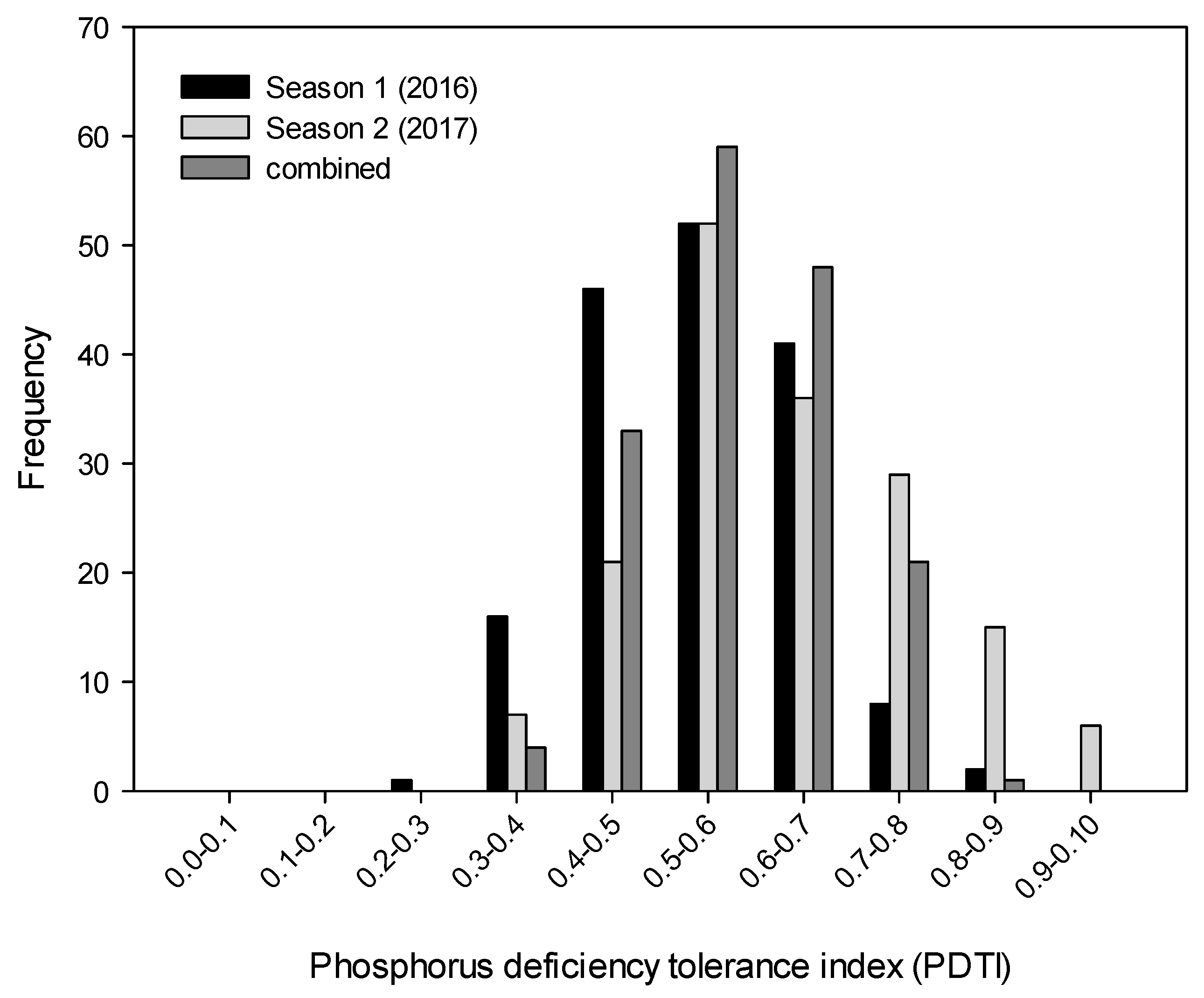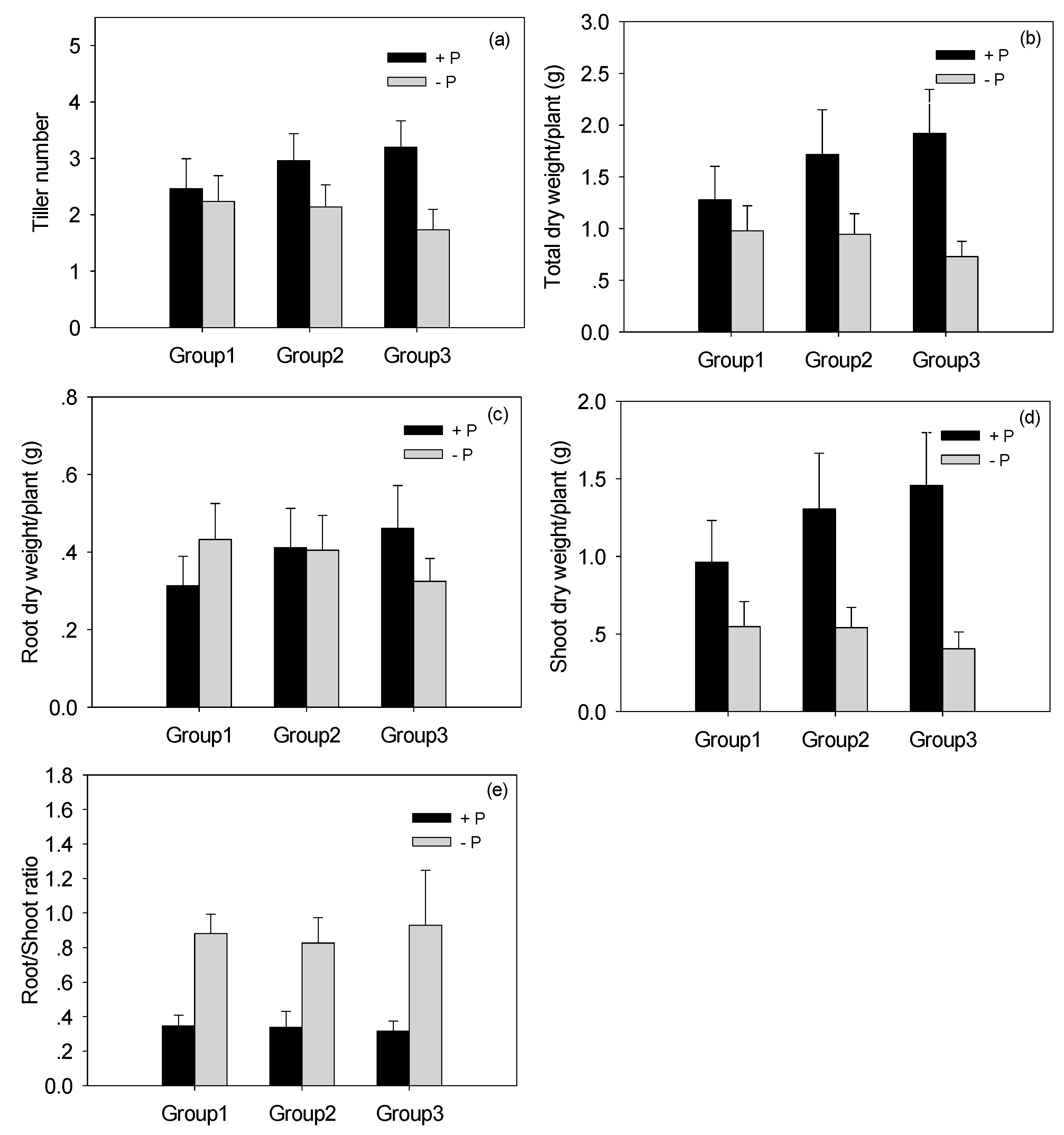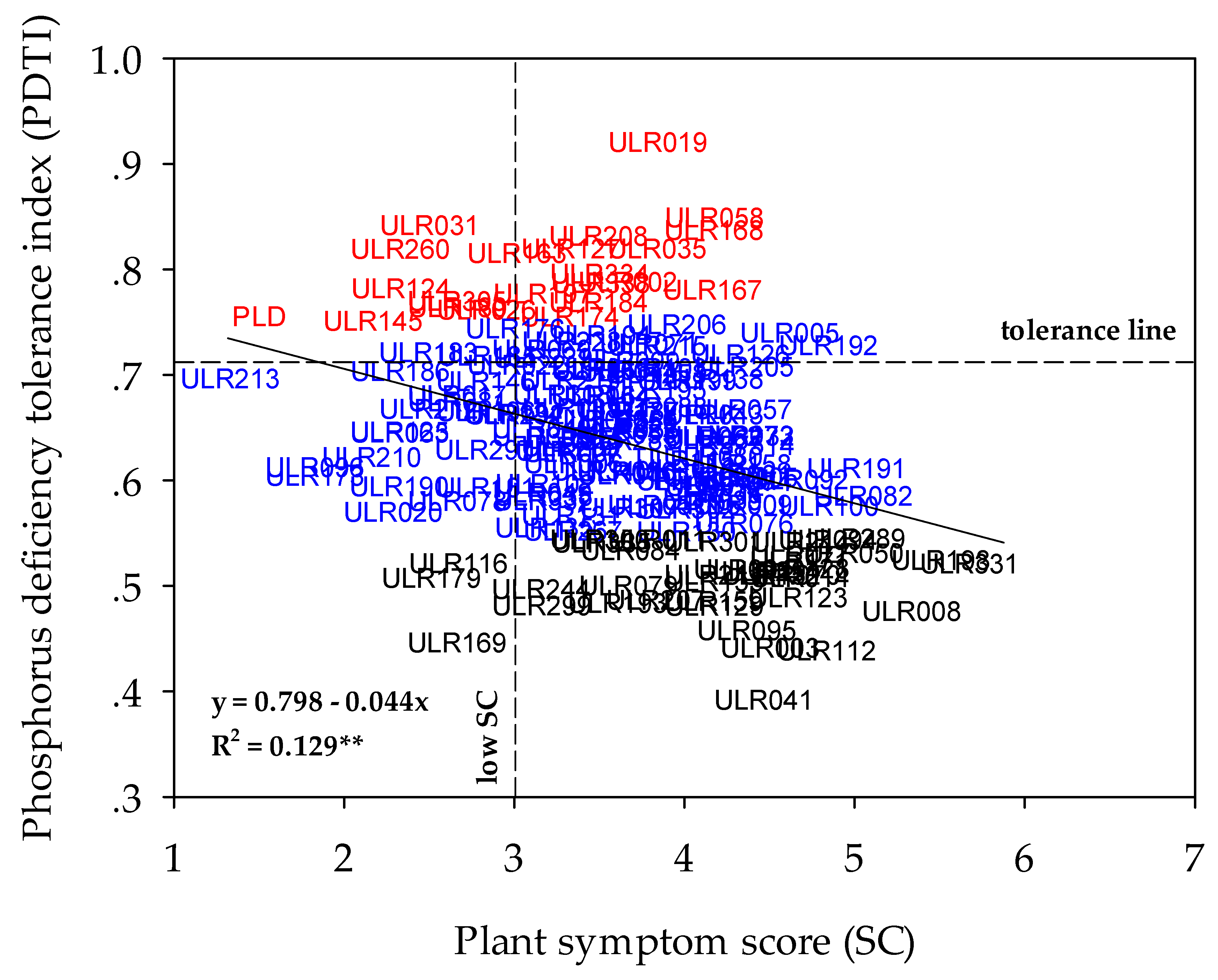Screening Tolerance to Phosphorus Deficiency and Validation of Phosphorus Uptake 1 (Pup1) Gene-Linked Markers in Thai Indigenous Upland Rice Germplasm
Abstract
:1. Introduction
2. Materials and Methods
2.1. Plant Materials
2.2. Greenhouse Evaluation
2.3. DNA Extraction and Pup1 Gene Validation
2.4. Statistical Analysis
3. Results and Discussion
3.1. Phenotypic Response of Tolerance to Phosphorus (P) Deficiency
3.2. Validating the Tolerance of Accessions by Pup1-Linked Markers
4. Conclusions
Author Contributions
Funding
Acknowledgments
Conflicts of Interest
References
- Shimizu, A.; Kato, K.; Komatsu, A.; Motomura, K.; Ikehashi, H. Genetic analysis of root elongation induced by phosphorus deficiency in rice (Oryza sativa L.): Fine QTL mapping and multivariate analysis of related traits. Theor. Appl. Genet. 2008, 117, 987–996. [Google Scholar] [CrossRef]
- Kirk, G.J.D.; George, T.; Courtois, B.; Senadhira, D. Opportunities to improve phosphorus efficiency and soil fertility in rainfed lowland and upland rice ecosystems. Field Crops Res. 1998, 56, 73–92. [Google Scholar] [CrossRef]
- Pinheiro, B.S.; Castro, E.; Guimarães, C.M. Sustainability and profitability of aerobic rice production in Brazil. Field Crops Res. 2006, 97, 34–42. [Google Scholar] [CrossRef]
- Yugi, R.A.; Hidayat, P.; Susanto, U. Drought tolerance, phosphorus efficiency and yield characters of upland rice lines. Emir. J. Food Agric. 2014, 26, 25–34. [Google Scholar]
- Ozturk, L.; Eker, S.; Torun, B.; Cakmak, I. Variation in phosphorus among 73 bread and durum wheat genotypes grown in phosphorus deficient calcareous soil. Plant Soil 2005, 269, 69–80. [Google Scholar] [CrossRef]
- Shimizu, A.; Yanagihara, S.; Kawasaki, S.; Ikehashi, H. Phosphorus deficiency-induced root elongation and its QTL in rice (Oryza sativa L.). Theor. Appl. Genet. 2004, 109, 1361–1368. [Google Scholar] [CrossRef] [PubMed]
- Raghothama, K.G.; Karthikeyan, A.S. Phosphate acquisition. Plant Soil 2005, 274, 37–49. [Google Scholar] [CrossRef]
- Koyama, T.; Chammek, C.; Snitwonge, P. Varietal differences of Thai rice in the resistance to phosphorus deficiency. Tech. Bull. Trop. Agric. Res. Cent. 1973, 4, 32. [Google Scholar]
- IRRI. IRRI Annual Report for 1984; International Rice Research Institute: Manila, Philippines, 1985. [Google Scholar]
- Hung, H.H. Studies on Tillering Ability of Rice Under Phosphorus Stress. Ph.D. Thesis, Texas A and M University, College Station, TX, USA, 1985. [Google Scholar]
- Fageria, N.K.; Morais, O.P.; Baligar, V.C.; Wright, R.J. Response of rice cultivars to phosphorus supply on an oxisol. Fertil. Res. 1988, 16, 195–206. [Google Scholar] [CrossRef]
- Chaubey, C.N.; Senadhira, D.; Gregorio, G.B. Genetic analysis of tolerance for phosphorus deficiency in rice (Oryza sativa L.). Theor. Appl. Genet. 1994, 89, 313–317. [Google Scholar] [CrossRef] [PubMed]
- Majumder, N.D.; Borthakur, D.N.; Rakshit, S.C. Heterosis in rice under phosphorus stress. Indian J. Genet. 1989, 49, 231–235. [Google Scholar]
- Wissuwa, M.; Yano, M.; Ae, N. Mapping of QTLs for phosphorus-deficiency tolerance in rice (Oryza sativa L.). Theor. Appl. Genet. 1998, 97, 777–783. [Google Scholar] [CrossRef]
- Wissuwa, M.; Ae, N. Genotypic variation for tolerance to phosphorus deficiency in rice and the potential for its exploitation in rice improvement. Plant Breed. 2001, 120, 43–48. [Google Scholar] [CrossRef]
- Wissuwa, M.; Wegner, J.; Ae, N.; Yano, M. Substitution mapping of Pup1: A major QTL increasing phosphorus uptake of rice from a phosphorus-deficient soil. Theor. Appl. Genet. 2002, 105, 890–897. [Google Scholar] [CrossRef] [PubMed]
- Sarkar, S.; Yelne, R.; Chatterjee, M.; Das, P.; Debnath, S.; Chakraborty, A.; Mandal, N.; Bhattacharya, K.; Bhattacharyya, S. Screening for phosphorus (P) tolerance and validation of Pup-1 linked markers in indica rice. Indian J. Genet. 2011, 71, 209–213. [Google Scholar]
- Chin, J.H.; Gamuyao, R.; Dalid, C.; Bustamam, M.; Prasetiyono, J.; Moeljopawiro, S.; Wissuwa, M.; Heuer, S. Developing rice with high yield under phosphorus deficiency: Pup1sequence to application. Plant Physiol. 2011, 156, 1202–1216. [Google Scholar] [CrossRef] [PubMed]
- Chin, J.H.; Lu, X.; Haefele, S.M.; Gamuyao, R.; Ismail, A.; Wissuwa, M.; Heuer, S. Development and application of gene-based markers for the major rice QTL phosphorus uptake 1. Theor. Appl. Genet. 2010, 120, 1073–1086. [Google Scholar] [CrossRef] [PubMed]
- Yoshida, S.; Forno, D.A.; Cock, J.H.; Gomez, K.A. Laboratory Manual for Physiological Studies of Rice, 3rd ed.; IRRI: Manila, Philippines, 1976. [Google Scholar]
- IRRI. Standard Evaluation System for Rice (SES); International Rice Research Institute: Manila, Philippines, 2002. [Google Scholar]
- Lodhi, M.A.; Ye, G.N.; Weeden, N.F.; Reisch, B.I. A simple and efficient method for DNA extraction from grapevine cultivars and Vitis species. Plant Mol. Biol. Rep. 1994, 12, 6–13. [Google Scholar] [CrossRef]
- Gamuyao, R.J.; Chin, H.; Tanaka, J.P.; Pesaresi, P.; Catausan, S.; Dalid, C.; Loedin, I.S.; Mendoza, E.M.T.; Wissuwa, M.; Heuer, S. The protein kinase Pstol1 from traditional rice confers tolerance of phosphorus deficiency. Nature 2012, 488, 535–540. [Google Scholar] [CrossRef]
- R Development Core Team. R: A Language and Environment for Statistical Computing; R Foundation for Statistical Computing: Vienna, Austria, 2008. [Google Scholar]
- Marschner, H. Marschner’s Mineral Nutrition of Higher Plants; Academic Press: New York, NY, USA, 2012; pp. 158–165. [Google Scholar]
- Dobermann, A.; Fairhurst, T. Rice: Nutrient Disorders and Nutrient Management; Oxford Graphic Printers: Manila, Philippines, 2000; p. 203. [Google Scholar]
- Aluwihare, Y.C.; Ishan, M.; Chamikara, M.D.M.; Weebadde, C.K.; Sirisena, D.N.; Samarasinghe, W.L.G.; Sooriyapathirana, S.D.S.S. Characterization and selection of phosphorus deficiency tolerant rice genotypes in Sri Lanka. Rice Sci. 2016, 23, 184–195. [Google Scholar] [CrossRef]
- Raghothama, K.G. Phosphate acquisition. Ann. Rev. Plant Physiol. Plant Mol. Biol. 1999, 50, 665–693. [Google Scholar] [CrossRef] [PubMed]
- Saito, K.; Linquist, B.; Atlin, G.N.; Phanthaboon, K.; Shiraiwa, T.; Horie, T. Response of traditional and improved upland rice cultivars to N and P fertilizer in northern Laos. Field Crops Res. 2006, 96, 216–223. [Google Scholar] [CrossRef]
- Ercoli, L.; Mariotti, M.; Masoni, A.; Massantini, F. Effect of temperature and phosphorus fertilization on phosphorus and nitrogen uptake by sorghum. Crop Sci. 1996, 2, 348–354. [Google Scholar] [CrossRef]
- Zhang, H.; Xu, R.; Xie, C.; Huang, C.; Liao, H.; Xu, Y.; Wang, J.; Li, W. Large-scale evaluation of maize germplasm for low-phosphorus tolerance. PLoS ONE 2015, 10, e0124212. [Google Scholar] [CrossRef] [PubMed]
- Koide, R.T.; Dickie, I.A.; Goff, M.D. Phosphorus deficiency, plant growth and the phosphorus efficiency index. Funct. Ecol. 1999, 13, 733–736. [Google Scholar]
- Heuer, S.; Lu, X.; Chin, J.H.; Tanaka, J.P.; Kanamori, H.; Matsumoto, T.; De Leon, T.; Ulat, V.J.; Ismail, A.M.; Yano, M.; et al. Comparative sequence analyses of the major quantitative trait locus phosphorus uptake 1 (Pup1) reveal a complex genetic structure. Plant Biotechnol. J. 2009, 7, 456–457. [Google Scholar] [CrossRef] [PubMed]



| Traits 1 | Season 1 (2016) | Season 2 (2017) | Combined 2 | |||||||||||||
|---|---|---|---|---|---|---|---|---|---|---|---|---|---|---|---|---|
| +P | CV (%) | −P | CV (%) | +P | CV (%) | −P | CV (%) | +P | CV (%) | −P | CV (%) | |||||
| S | G | S × G | S | G | S × G | |||||||||||
| Tiller number | 3.13 ** | 23.5 | 2.28 ** | 25.2 | 2.75 ** | 31.0 | 1.83 ** | 17.9 | ** | ** | * | 4.9 | ** | ** | ns | 9.1 |
| Plant height | 84.08 ** | 9.5 | 43.57 ** | 8.9 | 64.71 ** | 23.7 | 44.91 ** | 17.9 | ** | ** | ns | 18.5 | * | ** | * | 13.7 |
| SDW | 1.35 ** | 46.0 | 0.45 ** | 28.3 | 1.24 ** | 39.7 | 0.57 ** | 44.0 | ** | ** | ** | 10.3 | ** | ** | ** | 9.1 |
| RDW | 0.51 ** | 34.6 | 0.41 ** | 25.7 | 0.31 ** | 51.1 | 0.37 ** | 36.7 | ** | ** | ** | 9.6 | ** | ** | ** | 7.3 |
| TDW | 1.86 ** | 39.0 | 0.85 ** | 23.2 | 1.55 ** | 39.2 | 0.94 ** | 36.7 | ** | ** | ** | 9.3 | ** | ** | ** | 7.4 |
| RSR | 0.40 ns | 47.1 | 0.97 ** | 30.0 | 0.27 * | 61.9 | 0.75 * | 56.3 | ** | * | ns | 12.5 | ** | ** | ns | 9.8 |
| SC | NA | NA | 4.04 ** | 28.2 | NA | NA | 3.28 * | 32.9 | NA | NA | NA | NA | ** | ** | ** | 7.3 |
| DWR (%) | NA | NA | 47.74 ** | 41.8 | NA | NA | 34.14 * | 97.1 | NA | NA | NA | NA | ** | ** | ns | 15.9 |
| +P | |||||||
| Trait 1 | TN | TDW | RDW | SDW | |||
| +P | TDW | 0.645 ** | |||||
| RDW | 0.535 ** | 0.819 ** | |||||
| SDW | 0.634 ** | 0.986 ** | 0.712 ** | ||||
| RSR | −0.256 ** | −0.235 ** | 0.162 * | −0.336 ** | |||
| −P | |||||||
| TN | TDW | RDW | SDW | RSR | SC | ||
| −P | TDW | 0.606 ** | |||||
| RDW | 0.536 ** | 0.881 ** | |||||
| SDW | 0.579 ** | 0.952 ** | 0.695 ** | ||||
| RSR | −0.224 ** | −0.307 ** | 0.056 | −0.499 ** | |||
| SC | −0.293 ** | −0.291 ** | −0.356 ** | −0.216 ** | −0.098 | ||
| DWR | −0.225 ** | −0.334 ** | −0.371 ** | −0.274 ** | 0.072 | 0.361 ** | |
| Acc. | Pup1-K42 1 | Pup1-K43 | Pup1-K46 | Pup1-K52 | Pup1-K41 | PSTol-2 | K1 | K5 | K29-2 | Total Pup1 Linked Marker Bands | SC 2 | PDTI 3 |
|---|---|---|---|---|---|---|---|---|---|---|---|---|
| PLD | 1 | 0 | 0 | 1 | 1 | 1 | 0 | 1 | 1 | 6 | 1.50 | 0.76 |
| ULR026 | 0 | 0 | 0 | 1 | 0 | 0 | 0 | 0 | 1 | 2 | 2.84 | 0.76 |
| ULR031 | 0 | 0 | 0 | 0 | 0 | 0 | 0 | 1 | 0 | 1 | 2.50 | 0.84 |
| ULR124 | 1 | 0 | 0 | 0 | 1 | 1 | 1 | 0 | 1 | 5 | 2.33 | 0.78 |
| ULR145 | 1 | 0 | 0 | 1 | 1 | 1 | 1 | 0 | 1 | 6 | 2.17 | 0.75 |
| ULR180 | 0 | 0 | 0 | 0 | 0 | 0 | 1 | 0 | 0 | 1 | 2.67 | 0.76 |
| ULR183 4 | 0 | 0 | 0 | 0 | 0 | 0 | 0 | 0 | 0 | 0 | 2.49 | 0.72 |
| ULR185 | 0 | 0 | 0 | 0 | 0 | 0 | 1 | 0 | 1 | 2 | 2.84 | 0.72 |
| ULR186 | 0 | 0 | 0 | 0 | 0 | 1 | 1 | 1 | 0 | 3 | 2.33 | 0.70 |
| ULR213 4 | 0 | 0 | 0 | 0 | 0 | 0 | 0 | 0 | 0 | 0 | 1.33 | 0.70 |
| ULR260 | 1 | 0 | 0 | 0 | 1 | 1 | 0 | 1 | 1 | 5 | 2.33 | 0.82 |
| ULR305 | 0 | 0 | 0 | 0 | 0 | 0 | 0 | 0 | 1 | 1 | 2.66 | 0.77 |
© 2019 by the authors. Licensee MDPI, Basel, Switzerland. This article is an open access article distributed under the terms and conditions of the Creative Commons Attribution (CC BY) license (http://creativecommons.org/licenses/by/4.0/).
Share and Cite
Chankaew, S.; Monkham, T.; Pinta, W.; Sanitchon, J.; Kaewpradit, W.; Srinives, P. Screening Tolerance to Phosphorus Deficiency and Validation of Phosphorus Uptake 1 (Pup1) Gene-Linked Markers in Thai Indigenous Upland Rice Germplasm. Agronomy 2019, 9, 81. https://doi.org/10.3390/agronomy9020081
Chankaew S, Monkham T, Pinta W, Sanitchon J, Kaewpradit W, Srinives P. Screening Tolerance to Phosphorus Deficiency and Validation of Phosphorus Uptake 1 (Pup1) Gene-Linked Markers in Thai Indigenous Upland Rice Germplasm. Agronomy. 2019; 9(2):81. https://doi.org/10.3390/agronomy9020081
Chicago/Turabian StyleChankaew, Sompong, Tidarat Monkham, Wanwipa Pinta, Jirawat Sanitchon, Wanwipa Kaewpradit, and Peerasak Srinives. 2019. "Screening Tolerance to Phosphorus Deficiency and Validation of Phosphorus Uptake 1 (Pup1) Gene-Linked Markers in Thai Indigenous Upland Rice Germplasm" Agronomy 9, no. 2: 81. https://doi.org/10.3390/agronomy9020081
APA StyleChankaew, S., Monkham, T., Pinta, W., Sanitchon, J., Kaewpradit, W., & Srinives, P. (2019). Screening Tolerance to Phosphorus Deficiency and Validation of Phosphorus Uptake 1 (Pup1) Gene-Linked Markers in Thai Indigenous Upland Rice Germplasm. Agronomy, 9(2), 81. https://doi.org/10.3390/agronomy9020081





